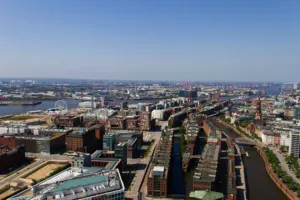How smart intervention in the land market could save us a lot of money
Published: by Toby Lloyd
Successive governments have promised to sell off large amounts of public land, to allow more homes to be built. As we wait for the long-awaited White Paper on housing we think it might be smarter for public authorities to be acquiring land instead. Here, guest blogger Thomas Hoepfner, cofounder and director of the New Garden Cities Alliance, tells the story of how Hamburg built a thriving new neighbourhood – and a new port – using this method.
Why should public authorities take a proactive approach to land acquisition? Lets think about that for a moment from citizens’ point of view: obviously, we have an interest in our tax money being spent in the most efficient way possible.
If our authorities announce that a piece of land is needed for public infrastructure, we should therefore object if a private individual or company buys it, and then holds the rest of us to ransom. Common sense tells us that this would mean we had to pay much more for the land than if we had bought before the new infrastructure proposal planning was in place.
In my hometown Hamburg, 25 years ago the Mayor and the head of the city-owned port authority agreed to prevent property speculation like this, for the benefit of the city and its citizens.
As container ships were getting larger the authorities had to increase the size of Hamburg’s harbour, in order to stay competitive. To the west of the harbour there was a largely agricultural area, which was already earmarked for future port development, but the problem was finding the money to fund the expansion when the city’s coffers were empty.
So they created the idea of developing Hafen City (Port City in English), on 100 hectares of port land directly adjacent to the inner city of Hamburg. The strategy was as follows: the Hafen City area would be redeveloped into a mixed-used, inner city district, using the inevitable uplift in land value to pay not only for the infrastructure, but also for the harbour extension to the west.
Much of the Hafen City land was owned by the city, but it had been leased to private companies on revolving 30 years contracts. If the authorities published their plans for Hafen City, these companies would demand hefty compensation – knowing that the city could afford to pay from the profits of the scheme, leaving nothing to fund the port extension.

Hamburg harbor – Foto: © Thomas Fries, Lizenz: cc-by-sa-3.0 de
So they set up a Special Purpose Vehicle, the Gesellschaft für Hafen- und Standortentwicklung (GHS), without specifying what it actually planned to do, and started secretly buying up the land over several years. By keeping the plans secret, they were able to get the land at fair prices, voluntarily agreed to by the private owners.
Unified land ownership then enabled a coherent masterplan for what was then Europe’s largest urban regeneration project to be approved in 2000. The authorities borrowed money to fund the E2.4bn of infrastructure, using the land as security for the loans. Once the infrastructure and the masterplan were in place, plots of land were sold off, capturing all the uplift in value and paying back the loans.
Today, Hafen City is widely regarded as a huge success, and is still growing every year, while the western extension to the harbour opened has also succeeded in allowing Hamburg to retain its status as the second busiest port in Europe after Rotterdam.
What would have happened if the authorities had announced their plans in advance? We’ll never know for certain, but it’s estimated that the cost would have been twenty times as great. And that cost would have been at the expense of the citizens of Hamburg.
Thomas-Emanuel Hoepfner